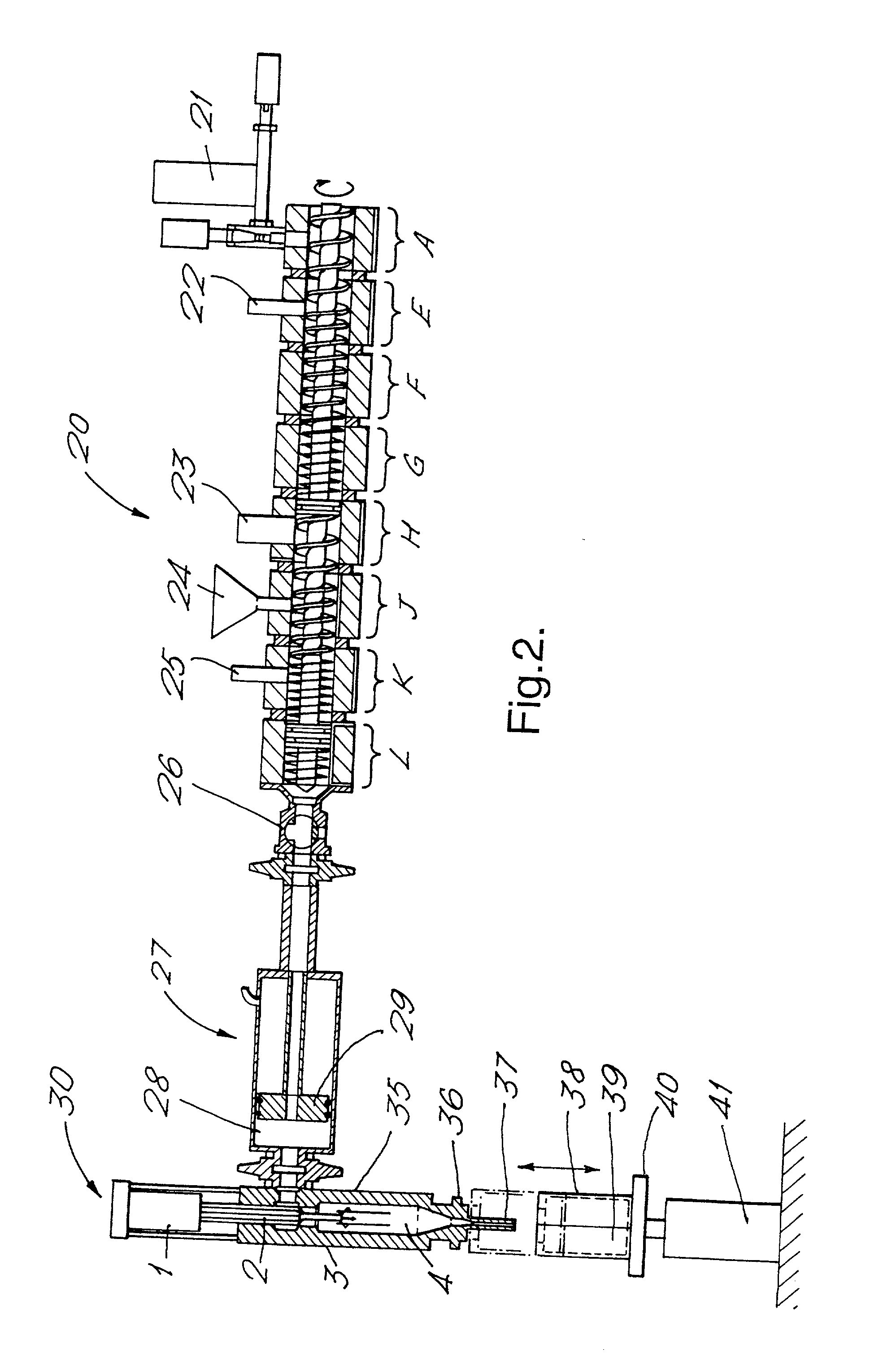Process for the production of a deodorant or antiperspirant product
a technology for antiperspirant products and deodorants, which is applied in the direction of packaging foodstuffs, instruments, packaged goods, etc., can solve the problems of increasing the overall energy consumption of the process, large volume of molten deodorant, and composition usually remaining in molten state for a long tim
- Summary
- Abstract
- Description
- Claims
- Application Information
AI Technical Summary
Problems solved by technology
Method used
Image
Examples
example 1
[0242] In Example 1, antiperspirant soft solid product of Formulation A summarised below was prepared employing apparatus according to FIG. 1, a Betol co-rotating twin screw extruder, having 30 mm diameter screws and eight temperature control zones leading via a connection valve to piston-type injection unit in which the connection valve and injection head were also temperature controlled. In this example, the extruder acted to transport the fluid antiperspirant composition to the injection unit.
[0243] Formulation A
1 Constituent % by weight Cyclomethicone (DC345) to 100% Hydrogenated castor oil and 10-12 Silicone wax (GE 1642) Emollient oil (Silkflo 364 NF) 12-16 Al-Zr antiperspirant active 23-25 Talc4-8% Suspending agent Bentone 38 clay) 1 Perfume 0.5-2%
[0244] A batch of a composition within Formulation A was prepared in conventional equipment to produce a solid mass and subsequently melted in a conventional stirred heating-jacketed vessel. It was maintained at a temperature of app...
example 2
[0249] In this Example, apparatus in accordance with FIG. 1 and substantially as described in Example 1, was employed to produce soft solid product from a composition within Formulation B. The screw extruder was operated over a range of from 100 to 400 rpm.
[0250] Formulation B
2 Constituent % by weight Cyclomethicone (DC245) to 100% Hydrogenated castor oil 5 Silicone wax (GE 1642) 6 Emollient oil (Finsolv TN) 12-16 AACH antiperspirant active 23-25 Talc4-8% Suspending agent Bentone 38 clay) 1 Perfume 0.5-2%
[0251] The composition was injected into the dispensing containers at a temperature controlled to within the range of 35 to 54.degree. C. The Theological properties of the products were assessed after they had cooled to ambient temperature. It was found that the products had very similar properties at both extremes of temperature of injection employed, showing that the injection moulding system is very tolerant of changes in the temperature of injection. A screw speed of 200 to 400 ...
example 3
[0252] In this Example, a pre-manufactured composition within Formulation C as shown below was conveyed via a twin screw extruder to an injection unit and injected into a dispensing barrel using the process described below.
[0253] Formulation C
3 Constituent % by weight beeswax and fatty alcohol structurants and 12 to 15 nonionic PEG ester emulsifier aqueous ACH antiperspirant active (50% 20 to 35 solution) benefit agents - (White pigment, 1.5-3 sunscreen, stabiliser, mineral oil) Perfume 1-1.5 water balance
[0254] In this Example, a product was made employing apparatus according to FIG. 2 and comprising a Werner & Pfleiderer co-rotating twin screw extruder having a plurality of temperature control zones, feeding an injection moulding apparatus having a low shear in-line injection head. The extruder had 30 mm diameter screws rotating at rates controlled within the range 100 to 500 rpm. In this Example, the extruder acted to transport the composition, subject it to low shear mixing and ...
PUM
| Property | Measurement | Unit |
|---|---|---|
| pressure | aaaaa | aaaaa |
| setting temperature | aaaaa | aaaaa |
| setting temperature | aaaaa | aaaaa |
Abstract
Description
Claims
Application Information
 Login to View More
Login to View More - R&D
- Intellectual Property
- Life Sciences
- Materials
- Tech Scout
- Unparalleled Data Quality
- Higher Quality Content
- 60% Fewer Hallucinations
Browse by: Latest US Patents, China's latest patents, Technical Efficacy Thesaurus, Application Domain, Technology Topic, Popular Technical Reports.
© 2025 PatSnap. All rights reserved.Legal|Privacy policy|Modern Slavery Act Transparency Statement|Sitemap|About US| Contact US: help@patsnap.com


